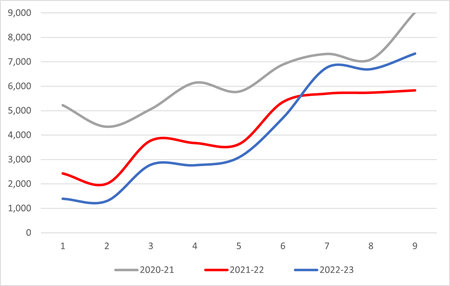CN’s preparations for this year’s harvest are well underway. Much like the Western Canadian farmers who spend weeks getting combines, trucks, augers, and grain carts ready to move into the fields, CN is working to ready its grain car fleet in advance of the fall crop.
Enhancing Reliability for the 2023 Grain Season
As of mid-July 2023, CN had over 4,100 cars, or over 36% of its Western Canadian grain hopper car fleet parked, of which 3,650 cars were in long-term storage. When rail equipment is stored for prolonged periods of time, comprehensive equipment inspections are required before it is brought back into service. Typically, CN completes car inspections and repairs between August and early September in preparation for the peak grain season demand.
That work is easier this year, thanks to a program CN implemented in the summer of 2022. CN’s summer reliability‑based maintenance program for car fleets uses repair data to identify cars with a high probability of failure and/or customer reject cars (cars with faulty gates or doors). CN has also implemented detector technology to identify cars with partially applied hand brakes. This technology helps reduce wheel defect frequency and improves fuel efficiency. Both initiatives help CN prioritize grain hopper car repairs and get cars back in service quickly.
Efficiency Through Improved Supply Chain Planning
CN’s work to improve the safety and reliability of its fleet pays off for the entire supply chain, just like the work farmers put in to ensure their equipment is harvest ready. Well-maintained equipment helps avoid costly breakdowns and delays. However, opportunities for further improvement remain. Supply chains work best when the right equipment is in the right place at the right time. To do this, supply chain partners need to share information and plan together to build demand forecasts.
Timely and accurate customer demand information is critical to support CN’s operational planning activities and maximize supply chain efficiency. In the absence of this information, CN is forced to make assumptions about trends in overall demand, both regionally and across individual shipment corridors. The supply chain can only perform to its full potential with accurate planning and data. Grain customers are best positioned to provide accurate demand signals.
 Figure 1. Demand for bulk grain movement for CN-supplied customer-supplied private grain hopper cars by grain shipment week over the past three crop years
Figure 1. Demand for bulk grain movement for CN-supplied customer-supplied private grain hopper cars by grain shipment week over the past three crop years
Navigating Harvest Variability
Trends are a poor substitute for accurate demand forecasts because no two harvests are the same. The chart below shows the significant variability in the timing of demand for bulk grain movement on CN for the past four crop years. The demand pattern shows even more fluctuation when it is broken down to the regional level. For example, spring seeding in the eastern Prairies last year was delayed by wet weather, which in turn pushed the harvest much further out than usual.
Forecasts Drive Reliable Supply Chains
There is no certainty surrounding a harvest. Harvest progress is different every year, and the onset of harvest varies regionally and for individual crops. It all starts with the timing of spring seeding - and every grain grower on the Prairies knows Mother Nature has the final say on when planting begins and ends. From there, every cereal, oilseed, and pulse crop has a ballpark range of days from planting to maturity, but again, the weather during the growing season has a big say in how quickly crop maturity comes on. And then there’s the impact of weather during harvest time. Combines don’t move when it rains. In such a variable environment, CN needs the latest on-the-ground information. That comes from customers. We need improved collaboration and accurate demand information from customers in order to deliver.
Scorecarding the End-to-End Grain Supply Chain
To improve transparency, and to promote improved collaboration across the supply chain, CN will include a scorecard in its monthly Grain Plan Updates this year. The scorecard will indicate whether bulk grain hopper car demand forecasts are supplied by major grain customers at a corridor level. Improved forecasts lead to better planning across the supply chain and help ensure grain cars are positioned when and where farmers expect to deliver their crops.
Through open communication and shared data, we can work together to identify areas for improvement, optimize processes, and ensure that every link in the supply chain operates at its peak performance.
LEARN MORE ABOUT GRAIN